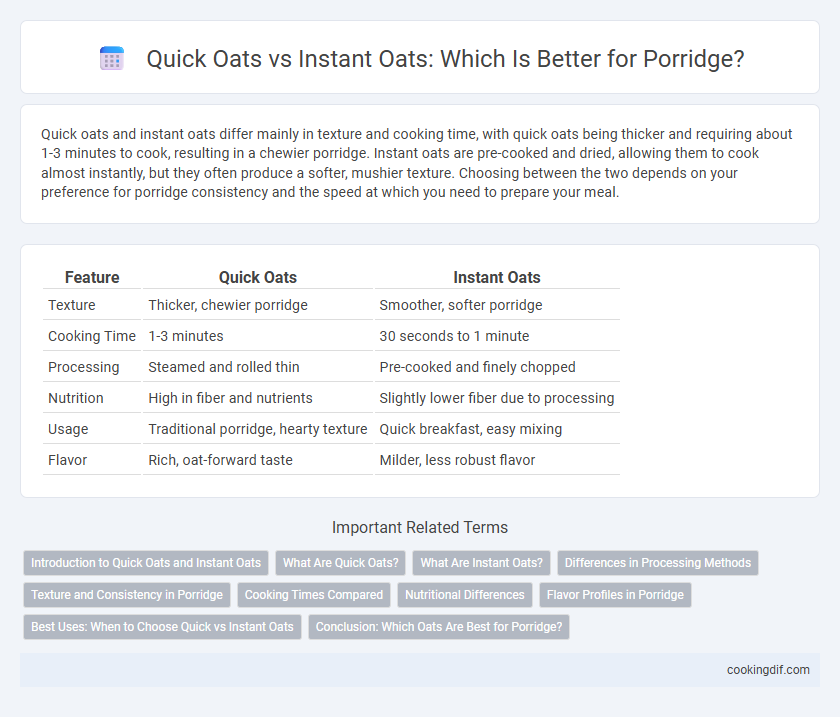Quick oats and instant oats differ mainly in texture and cooking time, with quick oats being thicker and requiring about 1-3 minutes to cook, resulting in a chewier porridge. Instant oats are pre-cooked and dried, allowing them to cook almost instantly, but they often produce a softer, mushier texture. Choosing between the two depends on your preference for porridge consistency and the speed at which you need to prepare your meal.
Table of Comparison
| Feature | Quick Oats | Instant Oats |
|---|---|---|
| Texture | Thicker, chewier porridge | Smoother, softer porridge |
| Cooking Time | 1-3 minutes | 30 seconds to 1 minute |
| Processing | Steamed and rolled thin | Pre-cooked and finely chopped |
| Nutrition | High in fiber and nutrients | Slightly lower fiber due to processing |
| Usage | Traditional porridge, hearty texture | Quick breakfast, easy mixing |
| Flavor | Rich, oat-forward taste | Milder, less robust flavor |
Introduction to Quick Oats and Instant Oats
Quick oats and instant oats differ primarily in processing and cooking time, with quick oats being rolled thinner and cut finer than old-fashioned oats, allowing for faster cooking while retaining more texture. Instant oats undergo further processing, often pre-cooked and dried, designed for the fastest preparation but typically yield a softer, mushier porridge. Choosing between quick and instant oats depends on desired porridge consistency and convenience, as quick oats offer a balance of speed and texture, whereas instant oats prioritize speed with a smoother result.
What Are Quick Oats?
Quick oats are oat groats that have been steamed, rolled, and cut into smaller pieces to reduce cooking time, making them ideal for quick-prepare porridge. They retain more texture and chewiness compared to instant oats, which are thinner and more finely processed for rapid absorption. Choosing quick oats ensures a balance of convenience and hearty consistency in porridge recipes.
What Are Instant Oats?
Instant oats are pre-cooked, dried, and rolled thinner than quick oats, designed for rapid cooking and easy digestion in porridge preparation. They absorb water quickly, resulting in a smoother and softer texture compared to the slightly coarser quick oats, making them ideal for a convenient, on-the-go breakfast. Despite the faster cooking time, instant oats often contain added sugar or salt, which may affect nutritional value compared to plain quick oats.
Differences in Processing Methods
Quick oats are produced by cutting rolled oats into smaller pieces and then steaming them briefly, allowing for faster cooking while retaining some texture. Instant oats undergo more extensive processing, including pre-cooking, drying, and flattening into finer pieces, resulting in a smoother consistency and the fastest cooking time. The difference in processing methods affects their cooking time, texture, and suitability for various porridge recipes.
Texture and Consistency in Porridge
Quick oats produce a thicker and chewier porridge texture due to their larger, less processed flakes, which absorb liquid more gradually. Instant oats yield a smoother, creamier consistency because they are pre-cooked and finely processed, allowing for faster water absorption and a softer mouthfeel. Choosing between quick and instant oats impacts the porridge's texture, with quick oats offering more bite and instant oats providing a velvety finish.
Cooking Times Compared
Quick oats cook in approximately 1 to 3 minutes, providing a balance between convenience and texture ideal for porridge. Instant oats are pre-cooked and dehydrated, requiring only 30 to 90 seconds to prepare, making them the fastest option for porridge but with a softer, less chewy texture. Choosing between quick oats and instant oats depends on desired cooking time and porridge consistency preferences.
Nutritional Differences
Quick oats and instant oats have similar nutritional profiles, providing comparable amounts of fiber, protein, and essential vitamins like iron and B vitamins. Instant oats often contain added sugars and flavorings, which can increase calorie and sodium content, making quick oats a healthier option for porridge. Both types are whole grain, but quick oats retain more texture and require less processing compared to instant oats, which influences glycemic index and satiety levels.
Flavor Profiles in Porridge
Quick oats have a slightly chewier texture and a nuttier, more robust flavor compared to instant oats, which tend to be softer with a milder, less complex taste. The processing of instant oats strips some of the natural oat flavor, resulting in a smoother but less pronounced porridge profile. For flavor-forward porridge, quick oats provide a heartier, more satisfying experience that highlights the grain's natural sweetness and earthiness.
Best Uses: When to Choose Quick vs Instant Oats
Quick oats are ideal for making porridge when you desire a creamy texture without long cooking times, as they retain some firmness and absorb liquid evenly. Instant oats cook fastest and are best for on-the-go meals or when convenience outweighs texture, often producing a softer, mushier porridge. Choose quick oats for stovetop or microwave porridge with moderate cooking time, and instant oats for rapid preparation using just hot water.
Conclusion: Which Oats Are Best for Porridge?
Quick oats and instant oats both offer convenience for porridge, but quick oats provide a better texture and slightly more nutrients due to less processing. Instant oats cook faster but tend to be mushier and often contain added sugars or flavorings that can alter the taste and nutrition. For a balance of texture, nutrition, and preparation time, quick oats are generally the best choice for porridge.
Quick oats vs instant oats for porridge Infographic

 cookingdif.com
cookingdif.com